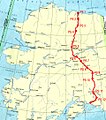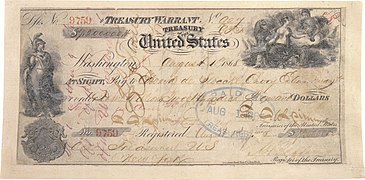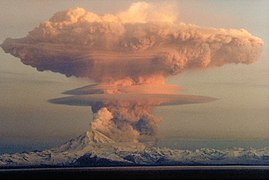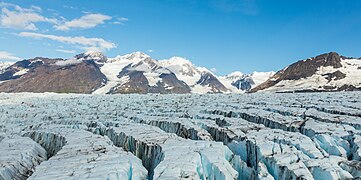Portal:Alaska
 Introduction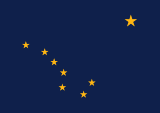   Alaska (/əˈlæskə/ ə-LASS-kə) is a non-contiguous U.S. state on the northwest extremity of North America. It is in the Western United States region and is considered to be the northernmost, westernmost, and easternmost (the Aleutian Islands cross the antimeridian into the eastern hemisphere) state in the United States. To the east, it borders Canada (the Yukon territory and the province of British Columbia). It shares a western maritime border, in the Bering Strait, with Russia's Chukotka Autonomous Okrug. The Chukchi and Beaufort Seas of the Arctic Ocean lie to the north and the Pacific Ocean lies to the south. Technically a semi-exclave of the U.S., it is the largest exclave in the world. Alaska is the largest U.S. state by area, comprising more total area than the next three largest states of Texas, California and Montana combined, and is the seventh-largest subnational division in the world. It is the third-least populous and most sparsely populated U.S. state, but is, with a population of 736,081 as of 2020, the continent's most populous territory located mostly north of the 60th parallel, with more than quadruple the combined populations of Northern Canada and Greenland. The state contains the second-largest and largest cities in the United States by area: the state capital of Juneau, and its former capital, Sitka, respectively. The state's most populous city is Anchorage and approximately half of Alaska's residents live within its metropolitan area. Indigenous people have lived in Alaska for thousands of years, and it is widely believed that the region served as the entry point for the initial settlement of North America by way of the Bering land bridge. The Russian Empire was the first to actively colonize the area beginning in the 18th century, eventually establishing Russian America, which spanned most of the current state, and promoted and maintained a native Alaskan Creole population. The expense and logistical difficulty of maintaining this distant possession prompted its sale to the U.S. in 1867 for US$7.2 million (equivalent to $157 million in 2023). The area went through several administrative changes before becoming organized as a territory on May 11, 1912. It was admitted as the 49th state of the U.S. on January 3, 1959. Abundant natural resources have enabled Alaska—with one of the smallest state economies—to have one of the highest per capita incomes, with commercial fishing, and the extraction of natural gas and oil, dominating Alaska's economy. U.S. Armed Forces bases and tourism also contribute to the economy; more than half the state is federally-owned land containing national forests, national parks, and wildlife refuges. It is among the most irreligious states, one of the first to legalize recreational marijuana, and is known for its libertarian-leaning political culture, generally supporting the Republican Party in national elections. The Indigenous population of Alaska is proportionally the second highest of any U.S. state, at over 15 percent, after only Hawaii. (Full article...) Entries here consist of Good and Featured articles, which meet a core set of high editorial standards.
 The Akutan Zero, also known as Koga's Zero (古賀のゼロ) and the Aleutian Zero, was a type 0 model 21 Mitsubishi A6M Zero Japanese fighter aircraft piloted by Petty Officer Tadayoshi Koga, that crash-landed on Akutan Island, Alaska Territory, during World War II. It was found intact by the Americans in July 1942 and became the first Zero acquired by the United States during the war that could be restored to airworthy condition. It was repaired and flown by American test pilots. As a result of information gained from these tests, American tacticians were able to devise ways to defeat the Zero, which was the Imperial Japanese Navy's primary fighter plane throughout the war. The Akutan Zero has been described as "a prize almost beyond value to the United States", and "probably one of the greatest prizes of the Pacific War". Japanese historian and lieutenant general Masatake Okumiya stated that the acquisition of the Akutan Zero "was no less serious" than the Japanese defeat at the Battle of Midway, and that it "did much to hasten Japan's final defeat". Conversely, John Lundstrom is among those who challenge "the contention that it took dissection of Koga's Zero to create tactics that beat the fabled airplane". The Akutan Zero was destroyed in a training accident in 1945. Parts of it are preserved in several museums in the United States. (Full article...)TopicsCategoriesSelected article -Star Air Service, later Star Air Lines and Alaska Star Airlines was an American air service in Alaska from 1932 to 1944. With financial help from a wealthy Alaska miner, three pilots who had started a flying school and charter business in Seattle, shipped an open-cockpit biplane by steamship to Alaska in March 1932. Star Air Service was incorporated in April, 1932 in Anchorage with capitalization of $4,000. The company had some early success training student pilots, but their airplane was destroyed in a crash. Their financial backer helped them purchase a larger plane with an enclosed cabin which supported winter operations. Three air services were founded in Anchorage in 1932. There was a surplus of airplanes, and not enough business to support them all, which prompted the 1934 merger of McGee Airways with Star Air Service. Star became the largest carrier in Alaska. A lack of financial resources and poor management continued to haunt the company. One of the founders lost his pilot's license and another died in a plane crash in 1936. With a change in management, the company was sold to a new group of investors in 1937, and renamed Star Air Lines. Government regulation of Alaska airline routes which began in 1938, along with continued financial instability of Alaska's air carriers prompted a consolidation within the industry. In 1942, Star Air Lines was purchased by New York City businessman Raymond Marshall. (Full article...)Selected picture - Fairbanks and the Alaska Range at midday during the winter solstice, looking south from the hills above Farmers Loop Road. Photo credit: User: Joe n bloe General imagesThe following are images from various Alaska-related articles on Wikipedia.
Recognized content
Featured articlesGood articles
Featured pictures
Former featured pictures
Related Portals
Related WikiProjectsState facts
State symbols:
Tasks
Associated WikimediaThe following Wikimedia Foundation sister projects provide more on this subject:
Discover Wikipedia using portals |
















